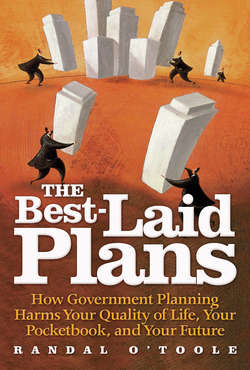Читать книгу The Best-Laid Plans - Randal O'Toole - Страница 31
На сайте Литреса книга снята с продажи.
8. Planning Is Not Necessary
ОглавлениеThe ultimate argument for government planning is that, even if it does not work very well, it is the only way to deal with certain social and environmental problems. In fact, almost everything that planners do could be done better, at lower cost, and with less intrusion into people’s lives, with properly designed user fees, markets, and incentives. While part seven will provide detailed examples of such proposals, it is appropriate here to examine the justification for planning.
The original justification for zoning was the need to protect residential neighborhoods from unwanted intrusions. Someone building a rental apartment in a neighborhood of high-quality single-family homes could charge higher rents because of the surrounding neighborhood, but the apartment might reduce the value of the nearby homes. As the U.S. Supreme Court wrote in its 1926 decision affirming the power of cities to zone, such an apartment building would be “a mere parasite, constructed in order to take advantage of the open spaces and attractive surroundings created by the residential character of the district.”1
But the market-based alternative to zoning—private neighborhoods protected by covenants, conditions, and restrictions—was created even before zoning. The first such private neighborhood, Gramercy Park in New York City, actually preceded zoning by nearly 90 years.2 By the time New York City passed the nation’s first zoning code in 1916, private communities had been created in New York, Boston, St. Louis, and other cities.
Such private neighborhoods had all been created from scratch. A developer subdivides land, writes the protective covenants, sells the lots or homes, and creates a homeowners’ association to enforce and, when needed, modify the covenants. This process did not work for neighborhoods that already existed without such covenants. Zoning was created for such neighborhoods. In retrospect, however, it was a mistake to give planners the authority over zoning, as today they use that authority to force some neighborhoods to accept high-density housing in the name of smart growth.
The better solution would have been to do as Houston has done. In place of zoning, many Houston neighborhoods have protective covenants. For those that do not, the city created a process allowing residents to petition their neighbors to create a homeowners’ association. If a majority of the neighborhood’s residents agree, the homeowners’ association is allowed to write new covenants. In essence, the Houston system allows every neighborhood to be its own zoning board.
Early 20th-century planners said planning was needed because of “market failure.” Since then, several generations of planners have left their marks on cities in the form of increasingly restrictive zoning codes. As a result, planners today no longer blame urban problems on market failure. Instead, they candidly admit that those problems are due to their predecessors’ mistakes. Past planners dedicated too much land to low-density housing, thus preventing people from learning the benefits of high-density, mixed-use developments. Past planners spent billions on highways, thus denying people the benefits of public transit.
There is some truth to this argument, though less than planners claim. To the extent that it is true, the appropriate solution is to relax existing rules, end subsidies, and let the market work. Instead, convinced they know best and are somehow immune to making the mistakes their predecessors made, many planners want to pass even more restrictive zoning codes mandating high-density housing and to devote huge subsidies to transit and other nonautomotive forms of travel.
Another argument for planning is that certain problems are regional and only regional government staffed by regional planners can solve those problems. This argument has been strongly promoted by former Albuquerque mayor David Rusk.3 In fact, most of the supposedly regional problems—including housing, open space, solid waste, infrastructure, and transportation—can easily be handled at the local level. The few problems that are difficult to solve locally are not made any easier by magnifying those problems to a regional scale. As Jane Jacobs wryly observes, a region is “an area safely larger than the last one to whose problems we found no solution.”4
Proponents of regional government often point to the hundreds of local governments, including fire, water, sewer, school, and other special districts, as well as counties and cities, that characterize most urban areas, as if this is a problem. But why should this be more of a problem than having hundreds of different homebuilders, retailers, doctors, lawyers, accountants, and other providers of goods and services competing for people’s business? Each special service district can concentrate on its particular problem and not get distracted by the complexity of regional issues. Moreover, local governments have long demonstrated that they can cooperate with one another on such issues as roads, water, and other infrastructure just as private parties cooperate on issues that they care about.
There are a few problems that markets cannot fully solve, but they are far less common than planning advocates will admit. Moreover, even for these problems, part seven will show that there are nongovernmental alternatives that work far better than comprehensive government planning.
In sum, the technical barriers—data, forecasting, modeling, and pace of change—to comprehensive, rational planning of land or other resources by government agencies are insurmountable. Because they cannot overcome these technical barriers, planners rely on junk science and resort to fads—and those fads cause far more problems than they solve. Instead of planning, governments should find alternative means of solving their problems, with an emphasis on user fees, markets, and incentives.
